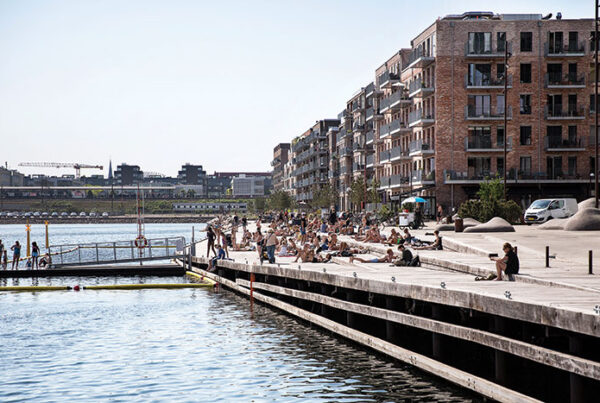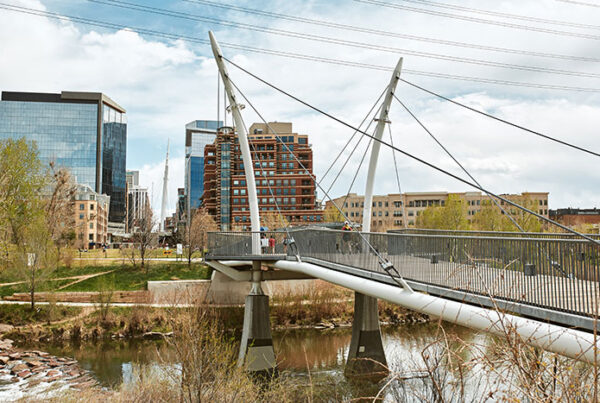Adapting to and mitigating the impacts of climate change have remained top priorities in Southeast Florida, even as the COVID-19 pandemic has tested other aspects of community resilience, said public-sector leaders participating in a recent ULI webinar hosted by ULI Southeast Florida/Caribbean.
In partnership with the University of Miami’s new Master of Professional Science in Urban Sustainability and Resilience program, the event featured insights from Dan Gelber, mayor of Miami Beach; Daniella Levine Cava, mayor of Miami-Dade County; and Crystal Wagar, immediate past mayor and current council member of Miami Shores Village. The mayors spoke about their current priorities, and in one case, shared how ULI helped shape their approach to climate adaptation. Attendees included members of ULI Southeast Florida’s Leadership Institute, an eight-month leadership and professional development program. This event occurred before the tragic condominium collapse in Surfside, Florida.
Moderated by district council executive director Julie Medley, the webinar is available on Knowledge Finder.
According to Gelber, implementing a resilience strategy informed by science and engineering experts is critical to ensuring a successful future for communities vulnerable to flooding and other climate change impacts. “The challenge of [addressing] resilience is that it’s often not a short-term answer. It’s a long-term answer. On the front end, it’s often costly, and can be disruptive, so our job (as mayors) is to demonstrate the political courage to take something that is in the top of the inbox and deal with it, instead of letting the next mayor deal with it,” he said. “It’s also our job to explain it to people and make sure they know that it’s important. And we have to get it right, because a ‘do-anything’ approach does not make sense when you are dealing with engineering solutions.”
Gelber credited assistance from a ULI Advisory Services panel in 2018 that resulted in the city of Miami Beach revising and broadening its climate adaptation plan, which initially was focused mainly on managing stormwater and sunny-day flooding through elevating streets and installing new pumps. The recommendations from the panel emphasized the need for the city to incorporate green and blue infrastructure more proactively, and to adopt a broad, long-range strategy that factors in regulatory changes to encourage more climate-resilient building design and development, as well as livability and economic issues. In the months after the panel, the city engaged a consultant to develop a green/blue infrastructure strategy and invited water management experts to sit on the local Historic Preservation Review Board.
Gelber was introduced to ULI Advisory Services program through the city’s involvement in the Rockefeller Foundation’s 100 Resilient Cities program, which funded the panel. “I wanted to ‘red team’ our approach (obtain an independent expert analysis). We wanted to know whether we were getting it right or wrong, because before I was going to tell residents that it would cost money and be disruptive, I wanted to make sure they knew it would be worth it. And ULI came back with a substantial study of our program, which was very important for us. We reimagined our program with ULI’s input, and I think our residents probably have more confidence in the program (as a result),” he said. That experience, said Gelber, underscored the value of “constantly challenging your own ideas and preexisting beliefs, because sometimes, somebody else will have done things better, and you should embrace their ideas.”
Levine Cava said that throughout the pandemic, she has kept reminding county residents that resilience must remain a key focus, noting that the COVID-19 outbreak has underscored the need for greater resilience against a variety of stressors, including health and social crises as well as environmental and economic crises. “The pandemic is the immediate threat, and one we can overcome. There will be other threats, but the threat of climate change and the need for adaptation and mitigation will persist. It (the threat posed by climate change) is affecting our very future as a community, and our community’s resilience is something that is all encompassing,” she said.
Levine Cava noted that Resilient305, the resilience strategy created jointly by Miami-Dade County and the cities of Miami and Miami Beach, included a pandemic as one of the threats to resilience, along with environmental-related threats such as rising sea levels. “Even as we emerge from the end of this particular pandemic, we need to have strategies in place for our future health, safety, and environmental challenges,” she said.
Recent surveys of county residents show that “across every income level, ethnicity, neighborhood, and demographic, our residents know we have an issue regarding climate change. Our community has to be more resilient, and persuading the public (to support efforts to improve resilience) is key,” she said. “The environmental community, the architects, the builders—all the people who are part of the resilience agenda—they have to be the messengers. They are truly the ambassadors for helping the public understand the necessity of focusing on this.”
Levine Cava cited a recent ULI publication, The Business Case for Resilience in Southeast Florida, that analyzes the economic risk that sea-level rise poses to the Southeast Florida, and the benefits of implementing adaptation measures. The report, commissioned by the Southeast Florida Climate Compact, found that the benefits of investing in building-level adaptation outweigh the costs four to one; it also found that the benefits of making community-wide investments outweigh the costs two to one. (In addition to the full report, an executive summary and materials that public officials can use to garner community support for resilience efforts are available on Knowledge Finder.) “We have to put an assets perspective on this, and I’m ready to do that,” she said.
Gelber noted that major resilience-related projects underway in Miami Beach—including the elevation of more than 50 miles (80 km) of roadways and the addition of more porous areas throughout the city—will not only help mitigate flooding, but also provide residents and businesses with bottom-line advantage through lower flood insurance costs and ultimately higher property values. “Doing this is worth the investment, because it will save residents money on flood insurance, and it will make their homes more valuable. And for businesses, this will preserve the value of those assets. It’s very important to explain that to people in the community,” he said.
The pandemic has provided an opportunity to learn from what worked and what has not, Gelber noted. “We (public officials in the Southeast Florida region) had an advantage going into the pandemic, because we have experience with hurricanes and other disrupters and we have learned how to work together harmoniously and seamlessly,” he said. “If we didn’t have to address these (common) issues, we might feel competitive with each other. Instead, we celebrate each other’s efforts.”
Mayor Wagar noted that funding resilience initiatives is particularly challenging for smaller communities such as Miami Shores Village, which is primarily a residential community with a limited tax base. “We don’t have the benefit of a large business community to boost our tax revenue, so cost is our issue. We are very involved in finding partnerships through grant funding, and in finding partnerships through our county, state, and federal governments. We have to constantly track opportunities that we can benefit from as a smaller municipality. It’s incumbent upon us to partner with our adjoining municipalities, as well as find corporate partnerships,” she said. “We also have to figure out how much of the costs we have to project onto residents and their properties. We cannot afford to ignore it (the impacts of climate change). The threat to our community is very real.”
Restoring the natural environment is among the community’s priorities to help improve resilience, Wagar noted. For instance, a major initiative is underway to create natural habitats throughout Miami Shores to help improve the water runoff system. The effort has required revising city codes and ordinances to allow residents to use natural elements to mitigate flooding that they’re experiencing in their neighborhoods, she said. “If a homeowner wants to create that to protect the quality of life in their space, I think they should be able to do it, and the overall impact of it is significant.”
Private-sector involvement is critical to support resilience efforts such as the installation of pumping stations in the community’s small commercial area, Wagar said. “We look to landlords and building owners to help us by implementing [flood] mitigation strategies. Anything they can do—and we can incentivize them to do—helps. As a municipality, we look for funding to pay for better drainage in our community. We have to protect folks who are having water pooling issues, and that’s the way our business community can help us,” she said.
Levine Cava pointed to the importance of private-sector involvement to help Miami-Dade County implement its sea-level rise strategy and its climate action strategy, both of which include actions related to building for resilience. The county’s “listening sessions” leading to the creation of the strategies yielded numerous examples of how wise development can be critical for mitigating flooding and adapting to sea-level rise, she said.
“A lot of smart architects and developers are doing far beyond what’s required because they want to be sustainable. Developers are playing a critical part in the public/private partnerships and in the dialogue on resilience,” Levine Cava said. “Builders and developers who are here for the long haul are the ones we need to really lift up. We’re looking to partner with converts—people who really recognize that resilient development is smart development. I want to lift up those who are doing the right thing, innovating, and showing us best practices. [In the public sector], we don’t only regulate; we learn from and listen to the industry, so we can work together to protect the long term [future of the community] and build smart.”
Gelber noted that science- and engineering-based solutions are going to “light the way” into the future of cities. “Challenges are literally coming to our doorstep, whether it is sea-level rise or a virus,” he said. “Engineering solutions make this [improving urban resilience] an entirely surmountable challenge if you have the political will and resources to do it. You read these stories about communities not being here 50 years from now, but we know that we can solve this problem so that our community will still be here if we put our nose to the grindstone and start doing it [implementing solutions].”


